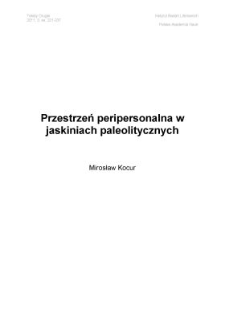- Wyszukaj w całym Repozytorium
- Piśmiennictwo i mapy
- Archeologia
- Baza Młynów
- Nauki przyrodnicze
Wyszukiwanie zaawansowane
Wyszukiwanie zaawansowane
Wyszukiwanie zaawansowane
Wyszukiwanie zaawansowane
Wyszukiwanie zaawansowane

Obiekt
Tytuł: Przestrzeń peripersonalna w jaskiniach paleolitycznych
Inny tytuł:
Wydawca:
Miejsce wydania:
Opis:
21 cm ; Tekst pol., streszcz. ang.
Typ obiektu:
Bibliografia:
1. M. Azéma, L’art des caverns en action, vol. 2, Les animaux figures. Animation et movement, l’illusion de la vie, Edition Errance, Paris 2010, s. 35-41.
2. P.G. Bahn Cave art. A guide to the decorated Ice Age caves in Europe, Frances Lincoln, London 2007, s. 118.
3. C. Barrière, L’art pariétal de la Grotte de Gargas / Palaeolithic Art in the Grotte de Gargas, avec la collaboration de A. Sahly et des élèves de l’Institut d’art préhistorique de Toulouse, trans. W.A. Drapkin, bilingual edition, Institute of Prehistoric Art of Touluse, t. 1-2, Toulouse–Oxford 1976.
4. A. Berti, F. Frassinetti, When far becomes near. Re-mapping of space by tool use, „Journal of Cognitive Neuroscience” 2000 vol. 4, s. 415-420.
5. S. Blakeslee, M. Blakeslee, The body has a mind of its own. How body maps in your brain help you do (almost) everything better, Random House, New York 2007, s. 108-109 i 133(Himba), 127-128 (Anlo i Paluti).
6. E. Bsiach, E. Capitani, C. Luzzatti, D. Perani, Brain and conscious representation of outside reality, „Neuropsychologia” 1981 vol. 19, s. 543-552. Por. E. Bisiach, C. Luzzatti, Unilateral neglect of representational space, „Cortex” 1978 vol. 14, s. 129-133.
7. B. Calvo-Merino, D.E. Glaser, J. Grèzes, R.E. Passingham, P. Haggard, Action observation and acquired motor skills. An fMRI study with expert dancers, „Cerebral Cortex” 2005 vol. 15, s. 1243-1249.
8. C. Classen, D. Howes, A. Synnott, Aroma. The cultural history of smell, Routledge, London 1994, s. 113-114, 118, 134, 137-138, 143-144, 147-148, 152-155.
9. S.A. de Beaune, R. White, Ice Age lamps, „Scientific American Magazine” March 1993.
10. L. Fogassi, V. Gallese, L. Fadiga, G. Luppino, M. Matelli, G. Rizzolatti, Coding of peripersonal space in inferior premotor cortex (area F4), „Journal of Neurophysiology” July 1996 vol. 76 no 1, s. 141-157.
11. J.P. Gallivan, C. Cavina-Pratesi, J.C. Culham, Is that within reach? fMRI reveals that the human superior parieto-occipital cortex encodes objects reachable by the hand, „The Journal of Neurosciene” 2009 vol. 29 no 14, s. 4381-4391.
12. K.L. Geurts, Culture and the senses. Bodily ways of knowing in an African community, University of California Press, Berkeley 2003.
http://dx.doi.org/10.1525/california/9780520234550.001.0001
13. M. Iacoboni, Mirroring people. The science of empathy and how we connect with others, Picador, New York 2008.
14. J. McPhee, A sense of where you are. A profile of William Warren Bradley, Farrar, Straus and Giroux, New York 1965.
15. G. Rizzolatti, C. Sinigaglia, Mirrors in the brain. How our minds share actions and emotions, trans. F. Anderson, Oxford University Press, Oxford 2008, s. 53-78.
16. D.R. Snow, Sexual dimorphism in Upper Paleolithic hand stencils, „Antiquity” 2006 vol. 80, s. 394 (390-404).
Czasopismo/Seria/cykl:
Zeszyt:
Strona pocz.:
Strona końc.:
Szczegółowy typ zasobu:
Format:
Identyfikator zasobu:
oai:rcin.org.pl:48027 ; 0867-0633
Źródło:
IBL PAN, sygn. P.I.2524 ; kliknij tutaj, żeby przejść
Język:
Język streszczenia:
Prawa:
Prawa zastrzeżone - dostęp nieograniczony
Zasady wykorzystania:
Digitalizacja:
Instytut Badań Literackich Polskiej Akademii Nauk
Lokalizacja oryginału:
Biblioteka Instytutu Badań Literackich Polskiej Akademii Nauk
Dofinansowane ze środków:
Program Operacyjny Innowacyjna Gospodarka, lata 2010-2014, Priorytet 2. Infrastruktura strefy B + R ; Unia Europejska. Europejski Fundusz Rozwoju Regionalnego
Dostęp:
Kolekcje, do których przypisany jest obiekt:
- Repozytorium Cyfrowe Instytutów Naukowych > Kolekcje Partnerów > Instytut Badań Literackich PAN > Czasopisma
- Repozytorium Cyfrowe Instytutów Naukowych > Piśmiennictwo > Czasopisma/Artykuły
Data ostatniej modyfikacji:
2 paź 2020
Data dodania obiektu:
19 wrz 2014
Liczba pobrań / odtworzeń:
2191
Wszystkie dostępne wersje tego obiektu:
https://rcin.org.pl./publication/65325
Wyświetl opis w formacie RDF:
Wyświetl opis w formacie RDFa:
Wyświetl opis w formacie OAI-PMH:
| Nazwa wydania | Data |
|---|---|
| Kocur M. - Przestrzeń peripersonalna w jaskiniach paleolitycznych | 2 paź 2020 |
Obiekty Podobne
Bawa, Seema
Karpowicz, Agnieszka
Szczodrowski, Henryk (1883–1954)

 INSTYTUT ARCHEOLOGII I ETNOLOGII POLSKIEJ AKADEMII NAUK
INSTYTUT ARCHEOLOGII I ETNOLOGII POLSKIEJ AKADEMII NAUK
 INSTYTUT BADAŃ LITERACKICH POLSKIEJ AKADEMII NAUK
INSTYTUT BADAŃ LITERACKICH POLSKIEJ AKADEMII NAUK
 INSTYTUT BADAWCZY LEŚNICTWA
INSTYTUT BADAWCZY LEŚNICTWA
 INSTYTUT BIOLOGII DOŚWIADCZALNEJ IM. MARCELEGO NENCKIEGO POLSKIEJ AKADEMII NAUK
INSTYTUT BIOLOGII DOŚWIADCZALNEJ IM. MARCELEGO NENCKIEGO POLSKIEJ AKADEMII NAUK
 INSTYTUT BIOLOGII SSAKÓW POLSKIEJ AKADEMII NAUK
INSTYTUT BIOLOGII SSAKÓW POLSKIEJ AKADEMII NAUK
 INSTYTUT CHEMII FIZYCZNEJ PAN
INSTYTUT CHEMII FIZYCZNEJ PAN
 INSTYTUT CHEMII ORGANICZNEJ PAN
INSTYTUT CHEMII ORGANICZNEJ PAN
 INSTYTUT FILOZOFII I SOCJOLOGII PAN
INSTYTUT FILOZOFII I SOCJOLOGII PAN
 INSTYTUT GEOGRAFII I PRZESTRZENNEGO ZAGOSPODAROWANIA PAN
INSTYTUT GEOGRAFII I PRZESTRZENNEGO ZAGOSPODAROWANIA PAN
 INSTYTUT HISTORII im. TADEUSZA MANTEUFFLA POLSKIEJ AKADEMII NAUK
INSTYTUT HISTORII im. TADEUSZA MANTEUFFLA POLSKIEJ AKADEMII NAUK
 INSTYTUT JĘZYKA POLSKIEGO POLSKIEJ AKADEMII NAUK
INSTYTUT JĘZYKA POLSKIEGO POLSKIEJ AKADEMII NAUK
 INSTYTUT MATEMATYCZNY PAN
INSTYTUT MATEMATYCZNY PAN
 INSTYTUT MEDYCYNY DOŚWIADCZALNEJ I KLINICZNEJ IM.MIROSŁAWA MOSSAKOWSKIEGO POLSKIEJ AKADEMII NAUK
INSTYTUT MEDYCYNY DOŚWIADCZALNEJ I KLINICZNEJ IM.MIROSŁAWA MOSSAKOWSKIEGO POLSKIEJ AKADEMII NAUK
 INSTYTUT PODSTAWOWYCH PROBLEMÓW TECHNIKI PAN
INSTYTUT PODSTAWOWYCH PROBLEMÓW TECHNIKI PAN
 INSTYTUT SLAWISTYKI PAN
INSTYTUT SLAWISTYKI PAN
 SIEĆ BADAWCZA ŁUKASIEWICZ - INSTYTUT TECHNOLOGII MATERIAŁÓW ELEKTRONICZNYCH
SIEĆ BADAWCZA ŁUKASIEWICZ - INSTYTUT TECHNOLOGII MATERIAŁÓW ELEKTRONICZNYCH
 MUZEUM I INSTYTUT ZOOLOGII POLSKIEJ AKADEMII NAUK
MUZEUM I INSTYTUT ZOOLOGII POLSKIEJ AKADEMII NAUK
 INSTYTUT BADAŃ SYSTEMOWYCH PAN
INSTYTUT BADAŃ SYSTEMOWYCH PAN
 INSTYTUT BOTANIKI IM. WŁADYSŁAWA SZAFERA POLSKIEJ AKADEMII NAUK
INSTYTUT BOTANIKI IM. WŁADYSŁAWA SZAFERA POLSKIEJ AKADEMII NAUK




































